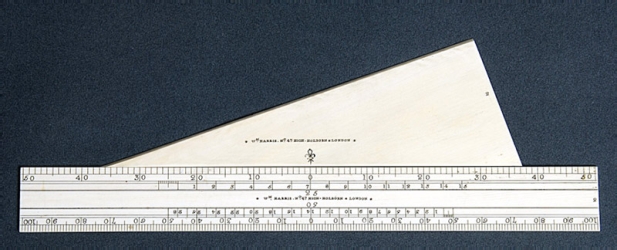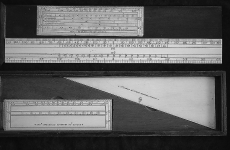Scientific Instrument Society 25th Anniversary Exhibition
Navigation:
<< First | < Previous | Next > | Last >>
16 Marquois Scales
Marquois scales were originally devised by Captain Marquois around 1780 for military surveying. This early 19th century part set by ‘Wm. Harris No. 47 High Holborn London’, consists of a 12 inch rule, with scales marked for 25/50 and 30/60 and a smaller than usual triangle. Originally the set would have included another 12-inch long scale, probably marked with divisions 20/40 and 35/45. The two 6 inch scale/protractors by West and Rubbergall, now present in the box, are very likely replacements for a single 6 inch scale/protractor by Harris which would have allowed space in the box for the missing 12 inch scale.
This Marquois set is unusual for being made of ivory instead of the more usual and thicker boxwood; secondly, what are termed the ‘Natural scales’ only occupy the central area of the scale rule, whereas normally both the Natural scales on the inside and the ‘Artificial scales’ on the outer edges would have continued for the whole length of the scale. When used with the triangle, the artificial scales allow for more accurate drawing of parallel lines.
Collection: John Bateman, Yorkshire
In 1761, Thomas Marquois, ‘Professor of Artillery and Fortification’, was granted a lease of the Norland estate, in a part of what is now Holland Park, Kensington, for use as an ‘academy for the civil or military education of sons of the gentry’. In 1763 he was styling himself ‘Master of the Military Academy at Norland’, leaving there in 1765. In 1783 his newspaper advertisement reads:
To the Curious in Drawing. Marquois Parallel Scales for drawing all kinds of plans, with the greatest accuracy, in less than half the usual time, particularly Fortification, answer every purpose of a Parallel Ruler, with the additional advantage of erecting Perpendiculars almost instantaneously, to any part of a given line. Their peculiar excellence consists in drawing lines parallel to each other, at any required distance without the assistance of Compasses.
Sold by the Inventor, No.1 Charing Cross, opposite Northumberland House, where the Purchaser will have them accurately made and explained.
N.B. The Military Sciences taught at home and abroad. A student under 15 years of age, may be instructed and accommodated with Board and Lodging, at One hundred Guineas per year.
Marquois does not claim they were newly invented, as was the custom at the time, nor does he say who makes them, and he was still at the same address in the following year.
P.D.
See: F.H.W. Sheppard, ed., Survey of London, vol.37, London 1973, p.276.
British Library, ‘A Plan of the Academy at Norlands, near Kensington Gravel Pits’, conducted by Thomas Marquois, Maps K. Top. 30.11-1.
Thomas Mortimer, The Universal Director 1763.
The Morning Herald and Daily Advertiser, No. 682, 4 January 1783.
Bailey’s British Directory, London 1784.
Objects lent by John Bateman, Yorkshire:
14. Triangular Compass, English, Late 18th Century


